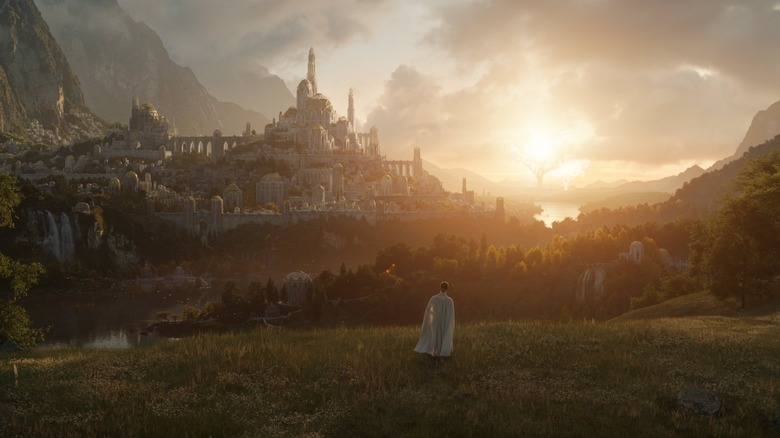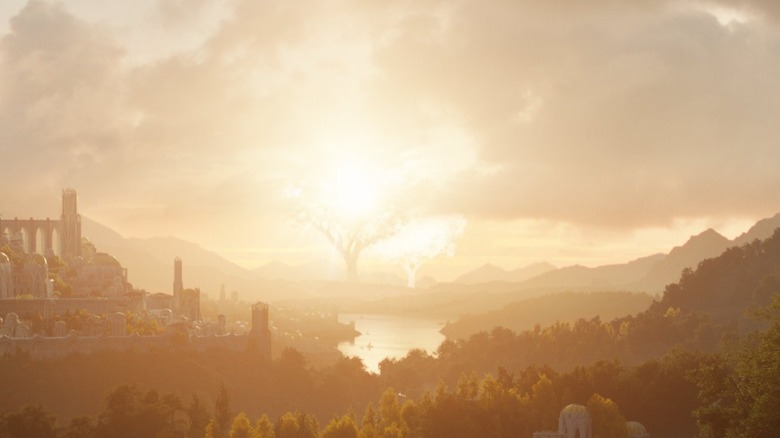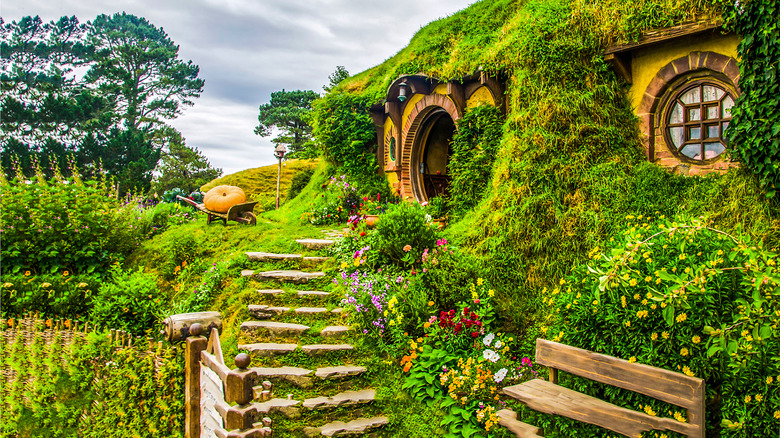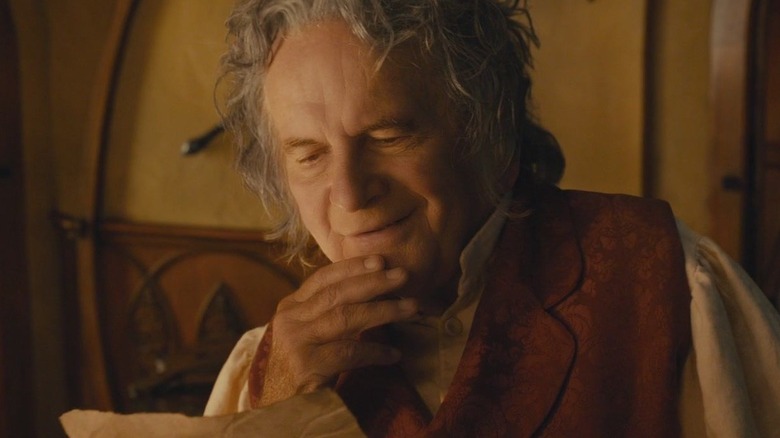The Not So Hidden Easter Egg In Amazon's First Look Middle-Earth Image
We may receive a commission on purchases made from links.
In early August, Amazon Studios posted a picture on its LOTRonPrime Twitter feed that completely blindsided everyone. Faithful Tolkienites and laissez-faire viewers alike gawked at a gorgeous picture that, at first glance, looked more like concept art than an actual still from a film.
The image was accompanied by a press release (posted at Amazon Studios) that boldly announced the series would be premiering on September 2, 2022, in over 240 territories — a global event, to say the least. The release was filled with news that electrified the fan base as it listed directors, producers, and actors who are all involved in the production. It also officially declared that filming of Season One had wrapped (that same day, no less).
The release also included the straightforward statement, "The new epic drama brings to screens for the very first time J.R.R. Tolkien's fabled Second Age of Middle-earth's history." Okay. What else is new? Ever since the studio released a series of cryptic map Tweets that included the comment "Welcome to the Second Age" way back in March of 2019, everyone and their mother has been talking about that era of Tolkienian history. That's where we need to come back to the picture for a second. See, the gorgeous still is filled with jaw-dropping Middle-earth glory. It shows a white city on a hilltop nestled between mountain spurs. A white-clad figure stands in the foreground, while the sun can be seen away on the horizon.
But it's that last part that requires closer attention. The dawn-like illumination is low to the ground and, upon closer examination, shows two silhouetted trees right in its midst. For any casual fan, this is a glorious panoramic of an other-worldly landscape that only J.R.R. Tolkien's genius, backed by a billion-dollar production budget, could create. But for Tolkien aficionados, it hints at much, much more.
Could it be the Two Trees of Valinor?
Early in Middle-earth history, tens of thousands of years before "The Lord of the Rings" takes place, the world is largely uninhabited. At this point, it's still being formed by the Valar and Maiar (via Tolkien Gateway), angelic beings that assisted the creator Illúvatar in shaping the lands. (Don't worry, none of this will be on the test.) The point is, while they were creating the world, they lit their working space with two giant lamps on posts at the northern and southern ends of the world. Eventually, the Dark Lord Morgoth comes along and causes some titanic mischief by toppling these lamps to the ground, putting out their light and breaking up the lands beneath them.
With their primary light extinguished, the Valar and Maiar head west to the Blessed Realm (also via Tolkien Gateway), where they build up a more protected, immortal area across the seas from Middle-earth proper. Once in their new home, one of the Valar named Yavanna sings two trees into existence, Telperion and Laurelin, and they're regularly referred to at Tolkien Gateway as the Two Trees of Valinor.
These trees aren't the kind of thing you'd find in your grandmother's garden. They're massive, and they emit light. How much light? How about enough to more or less light up an entire continent? Each one waxes and wanes on opposite cycles, creating a 12-hour day between the two of them.
The presence of two glowing trees in Amazon's picture seems to be referencing these two holy icons. After all, they appear to be gigantic and glowing — not your everyday woodland feature. Even if they aren't actually those particular two trees, they're clearly supposed to make informed viewers recollect the Two Trees without a second thought.
How early in Middle-earth history are the Two Trees?
The question is, is the fun easter egg little more than a call back to an earlier time in Middle-earth history as we prepare to dive into pre-"Lord of the Rings" lore? Or is it a bona fide hint about where the picture is taking place? It's an important inquiry. Why? Because the Two Trees don't exist in the Second Age. If these are the official Two Trees, we're looking at a much earlier time in Middle-earth legend.
Tolkien's enormous compendium of "The Silmarillion" is an overwhelming book in many ways, not the least of which is tracking time. The author went back and forth about how to measure time in his world, particularly during the time of the Two Trees, before the sun and moon are created. During this early era, time is measured by Valian Years, says Tolkien Gateway. In his posthumously published book "Morgoth's Ring," Tolkien explains that these years were "longer than are nine years under the Sun." While this definition changed over time, it's the most common measuring stick for early Middle-earth timelines.
Based on the "almost 10-to-one" Valian-to-solar years formula, the Two Trees of Valinor come into existence nearly 15,000 years before the Second Age begins. What's more, their destruction is one of the primary events that kicks off the First Age (roughly half a millennium before the Second Age) with the last fruit from each arboreal wonder being used to create the sun and moon.
What does all of this mind-numbing minutiae mean? If those are the Two Trees, we can be sure that we're not looking at Second Age Middle-earth. On the contrary, we're looking at a much, much earlier date in history, which leads to yet another stubborn head-scratcher that no one seems to be able to definitively answer so far: What time period is the show covering?
What time period are we talking about here?
If we're really seeing the Two Trees of Valinor in the first look photo and this really is a still that was pulled from the actual show, it would seem that Amazon Studios has permission to use more than just Second Age content in their production. This runs contrary to earlier rumors and reports claiming that the First and Third ages were "off-limits."
However, a recent leak on The One Ring.net also claimed that "elements & passages from 'The Silmarillion' and 'Unfinished Tales' are licensed by Amazon Studios for this adaptation." Perhaps the information was simply muddled in translation (as the entertainment rumor mill is so apt to do.) Then again, maybe Amazon is doing such a good job that they earned the rights to more content. After all, the same report from The One Ring claimed that the Tolkien Estate is "very happy with how things are progressing."
There are also a couple of other possible explanations. For instance, the show might have limited permission to include earlier content in flashback sequences that pertain to the primary narrative. Then again, there are limited references to earlier Middle-earth history throughout the "Lord of the Rings" and "Hobbit" trilogies, as well. Maybe the studio simply found an acceptable loophole.
The other option could be that the easter egg is little more than that, an easter egg. Maybe the show will release in September 2022 and we'll all laugh out loud at the fact that the inclusion of the trees was little more than a fun nod to the past. It might even be a purposeful red herring included to keep everyone off of the scent as the show slowly inches toward its release at what feels at best like the speed of a Valian Year.



